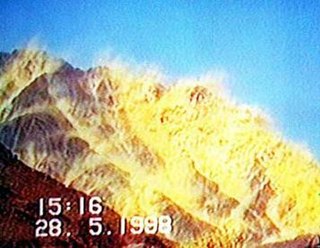Related Research Articles
Enriched uranium is a type of uranium in which the percent composition of uranium-235 has been increased through the process of isotope separation. Naturally-occurring uranium is composed of three major isotopes: uranium-238, uranium-235, and uranium-234. 235U is the only nuclide existing in nature that is fissile with thermal neutrons.

Uranium hexafluoride, sometimes called hex, is an inorganic compound with the formula UF6. Uranium hexafluoride is a volatile white solid that reacts with water, releasing corrosive hydrofluoric acid. The compound reacts mildly with aluminium, forming a thin surface layer of AlF3 that resists any further reaction from the compound. UF6 is used in the process of enriching uranium, which produces fuel for nuclear reactors and nuclear weapons.

Abdul Qadeer Khan,, known as A. Q. Khan, was a Pakistani nuclear physicist and metallurgical engineer who is colloquially known as the "father of Pakistan's atomic weapons program".

Yellowcake is a type of uranium concentrate powder obtained from leach solutions, in an intermediate step in the processing of uranium ores. It is a step in the processing of uranium after it has been mined but before fuel fabrication or uranium enrichment. Yellowcake concentrates are prepared by various extraction and refining methods, depending on the types of ores. Typically, yellowcakes are obtained through the milling and chemical processing of uranium ore, forming a coarse powder that has a pungent odor, is insoluble in water, and contains about 80% uranium oxide, which melts at approximately 2880 °C.

Gaseous diffusion is a technology that was used to produce enriched uranium by forcing gaseous uranium hexafluoride (UF6) through microporous membranes. This produces a slight separation (enrichment factor 1.0043) between the molecules containing uranium-235 (235U) and uranium-238 (238U). By use of a large cascade of many stages, high separations can be achieved. It was the first process to be developed that was capable of producing enriched uranium in industrially useful quantities, but is nowadays considered obsolete, having been superseded by the more-efficient gas centrifuge process (enrichment factor 1.05 to 1.2).

The Honeywell Uranium Hexafluoride Processing Facility, a uranium conversion facility, is located 1.9 miles (3 km) northwest of Metropolis, Illinois, United States. The plant, Honeywell Specialty Chemicals in Metropolis, Illinois, has a nominal capacity of 15,000 tU as uranium hexafluoride per year. ConverDyn, a general partnership between affiliates of Honeywell and General Atomics, is the exclusive agent for conversion sales from the Honeywell Uranium Hexafluoride Processing Facility.
Molecular laser isotope separation (MLIS) is a method of isotope separation, where specially tuned lasers are used to separate isotopes of uranium using selective ionization of hyperfine transitions of uranium hexafluoride molecules. It is similar to AVLIS. Its main advantage over AVLIS is low energy consumption and use of uranium hexafluoride instead of vaporized uranium.
The Urenco Group is a British-German-Dutch nuclear fuel consortium operating several uranium enrichment plants in Germany, the Netherlands, United States, and United Kingdom. It supplies nuclear power stations in about 15 countries, and states that it had a 29% share of the global market for enrichment services in 2011. Urenco uses centrifuge enrichment technology.

The Dr. A. Q. Khan Research Laboratories, is a federally funded and research and development national laboratory located in Kahuta at a short distance of Rawalpindi in Punjab, Pakistan. Established in 1976, the laboratory is best known for its central role in Pakistan's nuclear weapons program and its understanding the uranium science.
Separation of isotopes by laser excitation (SILEX) is a process under development to enrich uranium on an industrial scale for nuclear reactors. It is strongly suspected that it utilizes laser condensation repression to excite the uranium-235 isotope in uranium hexafluoride (UF6), allowing this lighter molecule to move more rapidly to the outer rim of a gaseous jet and resist condensing compared to the heavier, unexcited 238UF6. This differs greatly from previous methods of laser enrichment explored for their commercial prospects: one using atomic uranium (Atomic Vapor Laser Isotope Separation (AVLIS)) and another molecular method that uses lasers to dissociate a fluorine atom from 235UF6 (Molecular Laser Isotope Separation (MLIS)), allowing the enriched product to precipitate out as a solid.
The Defence Industry of Pakistan, established in September 1951, mainly falls under the purview of the Ministry of Defence Production (MoDP). It aims to foster collaboration and oversee the diverse range of military production facilities that have emerged since Pakistan's independence. The MoDP comprises specialized organizations, each dedicated to various aspects of the defence industry, including research and development, production, and administration.
The National Enrichment Facility (NEF) is a nuclear facility for the enrichment of uranium associated with the Los Alamos National Laboratory. The plant uses a gas centrifuge technology known as Zippe-type centrifuges. It is located 5 miles (8.0 km) east of Eunice, New Mexico. The NEF is operated by Louisiana Energy Services (LES), which is in turn owned by the Urenco Group. As of 2011, LES operates as URENCO USA.

The Portsmouth Gaseous Diffusion Plant is a facility located in Scioto Township, Pike County, Ohio, just south of Piketon, Ohio, that previously produced enriched uranium, including highly enriched weapons-grade uranium, for the United States Atomic Energy Commission (AEC), the U.S. nuclear weapons program and Navy nuclear propulsion; in later years, it produced low-enriched uranium for fuel for commercial nuclear power reactors. The site never hosted an operating nuclear reactor.
The Nuclear Fuel Factory (FCN)22.504°S 44.646°W is located near Resende, state of Rio de Janeiro, comprising three units, and has a production capacity of 280 tons of uranium per year. At present, FCN was modernized and produces at the Components and Assembly Unit the fuel rods and fuel elements needed for Brazilian nuclear reactors. The Reconversion and Pellets Production Unit is operating since 1999 with a capacity of 160 tons of UO2 pellets/year. The UO2 reconversion line uses the AUC process. The Nuclear Fuel Factory also produces other fuel element components, such as top and bottom nozzles, spacer grids and end plugs for export demands. Previously, Brazil supplied the uranium, which is transported to Canada where it’s converted into hexafluoride gas (UF6), and then to the United Kingdom for enrichment before it returns to Brazil for fabrication into fuel elements.
The Pakistan Nuclear Power Fuel Complex (PNPFC), also known as Chemical Reprocessing Plant (CrP), is a nuclear energy and reprocessing industrial complex for the PWR-type reactors. The NPFC-I is a dual purpose nuclear power plant, with a net capacity of 1000 MWe, located 175 km south of Islamabad. The reactor is designed for converting U3O8 to natural UF6, and enriched UF6 into UO2 powder, then converted depleted UF6 into depleted uranium metal and produced zircon ingot. The PNPFC is ingeniously constructed by the Pakistan Atomic Energy Commission (PAEC) under the IAEA terms, as IAEA is funding this megaproject.
The Zippe-type centrifuge is a gas centrifuge designed to enrich the rare fissile isotope uranium-235 (235U) from the mixture of isotopes found in naturally occurring uranium compounds. The isotopic separation is based on the slight difference in mass of the isotopes. The Zippe design was originally developed in the Soviet Union by a team led by 60 Austrian and German scientists and engineers captured after World War II, working in detention. In the West the type is known by the name of the man who recreated the technology after his return to the West in 1956, based on his recollection of his work in the Soviet program, Gernot Zippe. To the extent that it might be referred to in Soviet/Russian usage by any one person's name, it was known as a Kamenev centrifuge.

Project-706, also known as Project-786 was the codename of a research and development program to develop Pakistan's first nuclear weapons. The program was initiated by Prime Minister Zulfiqar Ali Bhutto in 1974 in response to the Indian nuclear tests conducted in May 1974. During the course of this program, Pakistani nuclear scientists and engineers developed the requisite nuclear infrastructure and gained expertise in the extraction, refining, processing and handling of fissile material with the ultimate goal of designing a nuclear device. These objectives were achieved by the early 1980s with the first successful cold test of a Pakistani nuclear device in 1983. The two institutions responsible for the execution of the program were the Pakistan Atomic Energy Commission and the Kahuta Research Laboratories, led by Munir Ahmed Khan and Abdul Qadeer Khan respectively. In 1976 an organization called Special Development Works (SDW) was created within the Pakistan Army, directly under the Chief of the Army Staff (Pakistan) (COAS). This organization worked closely with PAEC and KRL to secretly prepare the nuclear test sites in Baluchistan and other required civil infrastructure.
ConverDyn is a general partnership between American multinational firms General Atomics and Honeywell that provides uranium hexafluoride (UF6) conversion and related services to utilities operating nuclear power plants in North America, Europe, and Asia. The company is the sole marketing agent of UF6 produced at the Honeywell Uranium Hexafluoride Processing Facility in Metropolis, Illinois.
The Metallurgical Laboratory in Wah is a federally funded and research and development national laboratory located in Wah Cantonment in Punjab, Pakistan.
Depleted uranium hexafluoride (DUHF; also referred to as depleted uranium tails, depleted uranium tailings or DUF6) is a byproduct of the processing of uranium hexafluoride into enriched uranium. It is one of the chemical forms of depleted uranium (up to 73-75%), along with depleted triuranium octoxide (up to 25%) and depleted uranium metal (up to 2%). DUHF is 1.7 times less radioactive than uranium hexafluoride and natural uranium.
References
- ↑ Administration, United States Office of Export (July 1999). Export Administration Regulations. The Office. Retrieved 17 January 2024.
- ↑ "Wah - Pakistan Special Weapons Facilities". www.globalsecurity.org. Retrieved 17 January 2024.
- 1 2 "Wah - Pakistan Special Weapons Facilities" (html). nuke.fas.org. Federation of American Scientists. 4 June 2000. Retrieved 17 January 2024.
- 1 2 Khan, Feroz (7 November 2012). "(Secret Nuclear R&D Program)". Eating Grass: The Making of the Pakistani Bomb. Stanford, CA, USA: Stanford University Press. p. 500. ISBN 978-0-8047-8480-1 . Retrieved 24 January 2024.
- ↑ Pakistan Intelligence, Security Activities and Operations Handbook - Strategic Information and Developments. Lulu.com. August 2013. ISBN 978-1-4387-3722-5 . Retrieved 24 January 2024.
- ↑ Code of Federal Regulations. U.S. General Services Administration, National Archives and Records Service, Office of the Federal Register. 2000. Retrieved 24 January 2024.
